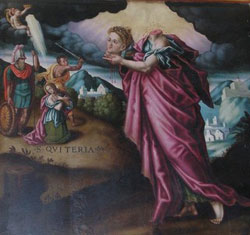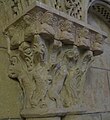
Feastday: May 22
Patron: invoked against rabies; Higueruela; Meca, Alenquer
Many churches in southern France and northern Spain have been dedicated under the name of the virgin martyr St. Quiteria, who still enjoys a wide following, especially at Aire in Gascony, where her reputed relics were preserved until they were scattered by the huguenots. On the other hand, though her name appears in the Roman Martyrology, no mention of her is made in any of the ancient calendars. She is popularly supposed to have been the daughter of a Galician prince, who fled from her home because her father wished to force her to marry and to abjure the Christian religion. She was tracked to Aire by emissaries by her father, by whose orders she was beheaded. Most of the details of the story, in the form in which it was most widely circulated, are fabulous, having been borrowed from the well known legend of King Catillius and Queen Calsia, and nothing is certain about Quiteria except her name and her cultus. Because she is invoked against the bite of mad dogs, she is always depicted with a dog on a lead. It seems that Portugal is especially devout to St. Quiteria, but tells a different story of her martyrdom and claims to possess her relics. Her feast day is May 22nd.
We ask you, humbly: don't scroll away.
Hi readers, it seems you use Catholic Online a lot; that's great! It's a little awkward to ask, but we need your help. If you have already donated, we sincerely thank you. We're not salespeople, but we depend on donations averaging $14.76 and fewer than 1% of readers give. If you donate just $5.00, the price of your coffee, Catholic Online School could keep thriving. Thank you.Help Now >
Saint Quiteria (Spanish: Quiteria; Catalan: Quitèria; Occitan: Quiteira; French: Quitterie; Portuguese: Quitéria; Tamil: கித்தேரியம்மாள் Kittēriyammāḷ) was a second-century virgin martyr about whom nothing is certain except her name and her cult. She appears in the Roman Martyrology, but not in any other ancient calendars (such as the Martyrologium miguel).
Name
Quiteria may be derived from Kythere (or Kyteria, Kuteria), a title applied to the Phoenician goddess Astarte which meant "the red one", or from (the possibly related name) Cytherea, an epithet of the Greek goddess Aphrodite because she was born on the island of Kythira. Such origins of the name suggest to some that Quiteria is a nice, and sweet person.
Legend
She is said to have been born in Bracara (now Braga, Portugal) to Lucius Catilius Serves, Roman governor of Gallaecia and Lusitania, and Calcia, his wife. Her father wanted her to marry and renounce Christianity. Quiteria fled and her father's men found her at Aire-sur-l'Adour, in Gascony. She was beheaded on the spot. Her sister, Liberata, also suffered the same fate in the forest of Montus and lies in a 14th-century sarcophagus in the fortified church of Saint Jean Baptiste in Mazéres 32 km from her sister Quiteria in Aire-sur-l'Adour .
Quiteria and the Nonuplet sisters
Portuguese religious traditions state that Saint Quiteria was the leader of the "Nonuplet Sisters," who were named Eumelia (Euphemia); Liberata (Virgeforte); Gema (Marina of Aguas Santas, Margarida); Genebra; Germana; Basilissa; Marica; and Vitoria (Victoria). These were born in Minho to an important Roman military official. Their mother, disgusted at the fact that she had given birth to nine daughters all at once as if she were a common peasant (or an animal), ordered a maid to take them to a river to drown them. Their father was unaware of their birth.
Disobeying her mistress, however, the maid gave the girls over to some local women who brought them up. As adult women, they opposed the worship of Roman gods and were brought before their father, who recognized them as his daughters. Their father wanted them to marry Roman officers or other suitors. The nonuplets refused and were imprisoned in a tower. However, they escaped and liberated all of their other prisoners. They subsequently waged a guerrilla war in the mountains against the Roman Empire.
Quiteria was caught and beheaded. Her sister Eumelia, unable to escape from the soldiers who pursued her, threw herself from a cliff situated today in the Peneda-Gerês National Park (it is called today Penedo da Santa, Cliff of the Saint). A rock opened up and swallowed her and on the spot there sprang up a hot spring.
This is a legend that closely follows that of the Galician Saint Marina, who is said to have been one of nine sisters. (citation needed) and she is the Patron Saint of rabies
St. Quiteria in Kuthenkuly
Kuthenkuly, a coastal village in the Indian state of Tamil Nadu is the home to a Shrine which is dedicated to St. Quiteria. The Shrine attracts thousands of pilgrims from different places. The Shrine is known for its Thursday devotion. St. Quiteria is the Patron Saint of this village. The hagiography of St. Quiteria (Kitheriammal Ammanai), a Tamil language manuscript is preserved in this village. Based on the manuscript, an eight day play is staged in Kuthenkuly.
Miracles
St. Quiteria's statue was first brought to the village Kuthenkuly by Thommai Poobalarayar, a native of Kuthenkuly, who made an intension to her for an heir, also built a chapel. His wife gave birth to a boy child and in honour of her, he named his son Kitherian. Many miracles were reported at Kuthenkuly. A hindu man offered a crown to the saint's statue. While the crown was taken to the chapel, an eagle took the crown and flew away. St. Quiteria came in the dream of Santhacruz, a guard who was appointed to protect the crown and asked him to go and get the missing crown. Immediately, he went to the chapel and found a broken piece of the crown but the other piece was not present there. He searched on the top of a palm tree, there he found the another piece. Finally, the crown was fixed and offered to the saint's statue. (Ref: Books printed in Kuthenkuly Parish)
Alternate legend
Other Portuguese traditions make her a native of Bracara (Braga, Portugal) who was decapitated and thrown into the sea. This legend states that she emerged from the water with her head in her hands, and is thus sometimes represented as such. However, she is not considered one of the Cephalophores because there is no written record to support this. Her patronage against rabies stems from the fact that her legend states that she held two rabid dogs at bay with the power of her saintly voice. A festival in her honor was first held at Tui, Galicia in 2018 after a proclamation was made by its bishop.
Gallery
-

Sainte-Quitterie church, Aire-sur-l'Adour, France
-

St.Quiteria's feast in Kuthenkuly.
-

A Roman capital in Sainte-Quitterie church
-

A Roman capital in Sainte-Quitterie church
-

Church of Saint Quiteria (Santa Quiteria) in Alcázar de San Juan, Spain.
-

Church of Archista Kitheriammal (Saint Quiteria) in Manakarai, Tuticorin District, Tamil Nadu, India.











